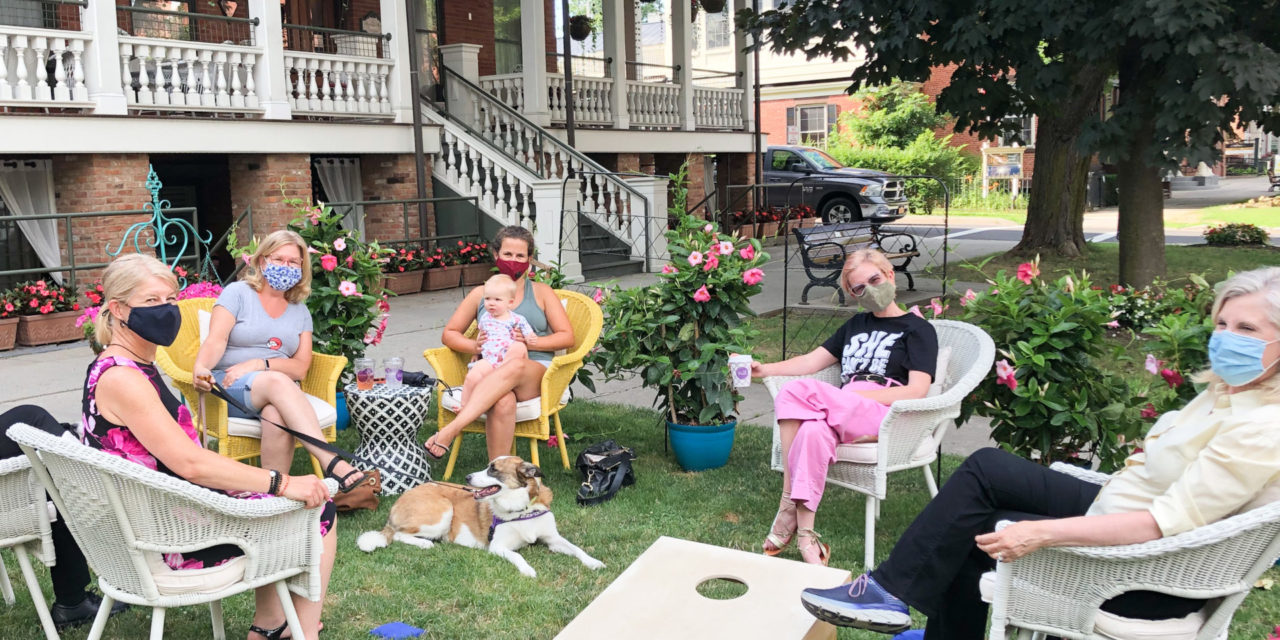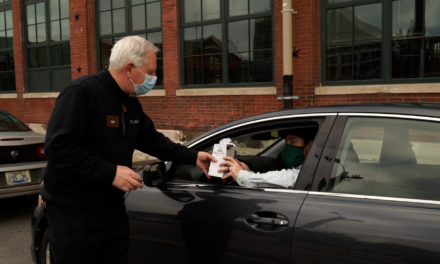The economic, social, and cultural impact of the coronavirus pandemic is so vast and deep, it seems almost impossible to measure, never mind comprehend. As the Congressional Budget Office warns of at least a decade of stubbornly high unemployment and a depressed economic output, and as every country, industry and individual waits to discover what the “new normal” means, some cities are opting to redefine it themselves—proactively.
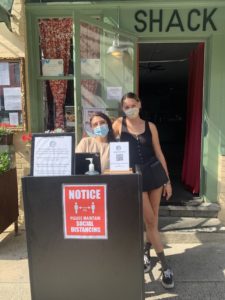
Hattie’s Chicken Shack [Photo courtesy Beth Anderson]
On paper, Saratoga Springs is a small town. But it has the spirit—and spirits—of a buzzing metropolis. Saratoga has been punching above its weight class since the 19th century, when it was dubbed Queen of the Spas by titans of industry who summered there, the Vanderbilts, Whitneys and Morgans.
These days, the city’s population swells from less than 30,000 to close to 80,000 between July and September with an influx of visitors eager to take advantage of eight-week racing season at the Saratoga Race Course as well as a wide variety of cultural offerings, opportunities for outdoor recreation, and the 20 or so natural springs that flow throughout town, each of which tastes and smells different and are believed by some to harbor health-restoring minerals).
Pre-global pandemic, the hospitality and tourism industry had a $1 billion impact on Saratoga County’s economy, with $69 million ultimately going into local and state tax coffers. Much of that revenue arrived during the time between shut-down and Labor Day. The tourism industry, pre-COVID-19, created and sustained around 11,500 jobs, according to a study conducted by the Saratoga County Prosperity Project.
The robust restaurant and bar scene (Saratoga has one of the highest number of restaurants per capita in the country) kept this small town buzzing with a big city life year-round.
SHUT DOWN
When Governor Andrew Cuomo shut down bars and restaurants across New York state on March 16, Saratoga Springs turned from bustling mini-metro into a ghost town. And the hits kept coming: schools went virtual, the racing season was canceled, concert halls and museums were shuttered, anything deemed “non-essential” was nixed.
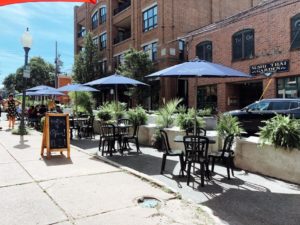
[Photo courtesy Beth Anderson, Hattie’s]
Maciel and multiple local-business owner Catherine Hover (Saratoga’s Paint & Sip, community and work space Palette Café in Saratoga Springs and soon, Schenectady), who sat together on Saratoga’s Complete Streets Board for two years, say they quickly realized that if they didn’t act quickly and successfully implement portions of their plan for a more spacious and people-centric cityscape, the reverberations for the local economy—and multiple levels—would be devastating. They’d been petitioning the city for years with a micro-version of their vision, to no avail.
“We wanted to remove just one parking space on Henry Street in front of Paint & Sip, and extend the sidewalk for seating or retail,” Maciel says of her work with Hover. “The concept of the ‘parklet’ was pioneered in cities like San Francisco and Vancouver, and has been shown to boost business and resident engagement. But [back then] it went nowhere.”
Then, the pandemic.
Shortly after shutdown, and realizing that beginning the process of approvals while restaurants were still shuttered would be their best route to success, the pair called and emailed business owners to see if they could get enough support to fast-track a super-sized series of parklets. Meanwhile, the bars and restaurants they were reaching out to were busily applying for emergency loans, trying to figure out how to pivot to take-out, furloughing staff, and generally just trying to stay afloat.
Until early June, no form of dining—aside from take-out—was permitted. But during Phase II of reopening, it was finally allowed. And yet, it still felt incredibly unsafe and logistically unmanageable for businesses and guests.
“There was no way for the small restaurants all over downtown to open their doors and function safely,” Maciel says. “If they put tables on the sidewalk at a proper six-foot distance, people wouldn’t have enough room to walk past safely, and wheelchairs wouldn’t be able to operate on the sidewalks at all.”
While Saratoga Springs restaurants and bars could technically allow indoor dining as long as groups were kept six feet apart and anyone standing up wore a mask at all times, most people were unwilling to do that. Maciel and Hover believed their plan to create multiple parklets and shut down certain restaurant-heavy streets to vehicular traffic altogether was the only way to create enough space for bars and restaurants to reopen safely and successfully, pay their bills, keep their teams employed, and generally recreate the buzzing mini-metro—with a mom-approved, safety-first mentality.
“We had to shift paradigms quickly, which isn’t easy. Catherine and I approached every business individually, showed them our drawings and plans, which took into account parking alternatives and technical details,” Maciel recalls.
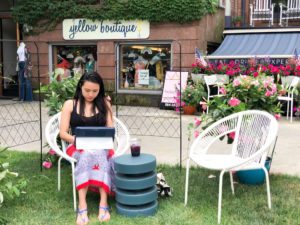
[Photo courtesy Caroline Hover, Palette]
“We weren’t going to let it go,” Hover says. “This isn’t just my livelihood we’re talking about, which is important enough. This is my life. I have three children who I want to raise in a thriving community. Erin and I saw this as our chance to show not just other businesses, but our children, that we are going to show up for our community. That we care. That we all have a role to play, and we can all make a difference.”
On June 16, the city passed legislation letting bars and restaurants extend their permits to allow outdoor dining on “contiguous private and public property.” By June 29, parklets were erected on Henry Street, allowing Scallions, the Henry Street Taproom, Flatbread Social and Saratoga Paint & Sip to take over the streets with sidewalk, with plenty of room for pedestrians and wheelchairs.
The Phila Street parklet was installed July 20, with Peabody’s, Hattie’s, Sweet Mimi’s, Solevo, Sushi Thai Garden, and Phila Fusion Noodle Bar getting the space to welcome people safely.
Originally, they parklet permits were set to expire on Labor Day, but they’ve already been extended through mid-October.
IMPACT AND REACTIONS
“Restaurants operate on razor-thin margins during the best of times, so this has been challenging to say the least,” says Ryan McFadden, co-owner (with his wife, Sonja) of Flatbread Social and The Henry Street Taproom. “The parklets have really helped us, because they essentially doubled the capacity we could have with social distancing in place.”
Plus, he and other business owners noted, the vast majority of guests are choosing to dine outdoors. Indoors still feels risky.
According to McFadden, the Taproom’s business is down about 35 to 40 percent, year over year, but before the parklet opened, it was down about 70 percent. Flatbread, which was able to pivot its menu to takeout more easily, and has been able to hold about 75 percent of its business year-over-year. The parklet has propped them up, as has a Paycheck Protection Program (PPP) loan, which landed in March and helped them pay staffers, utilities, and rent. Their landlord is also cutting them a break.
As Maciel herself point out, the parklets are not a panacea.
“Having the parklets has made a huge difference, but we’re really just hanging on downtown,” says Beth Alexander, co-owner (along with her husband, Jasper) of Hattie’s Restaurant. Hattie’s has two locations: one is a more formal sit-down restaurant on Phila Street, and another is a more casual ,dine-in and take-out restaurant called Hattie’s Chicken Shack, located in a commercial district just outside of town.
“We’re really lucky to have both locations, and the staff at the Chicken Shack has stepped up,” Alexander says, adding that sales there are about flat. “All told, we’re 50 percent down, year-over-year. About 70 percent of our money comes from the summer months, and we save it for the lean months. But if we didn’t have the parklet? I can’t even imagine where we’d be.”
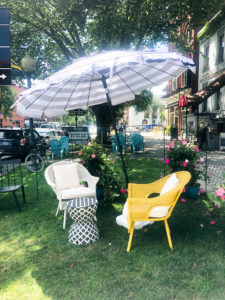
[Photo courtesy Caroline Hover, Palette]
“We have a great team, and we’re super lucky that they were willing to take a pay cut to help us,” she says.
For residents, the parklets have been a welcome respite from the doldrums of the pandemic.
“Every restaurant has decorated its section differently, and it gives our little city such a vibrant and inviting feeling,” says Christa Hyland, a resident and realtor for Howard Hanna. “With the space, I feel comfortable dining with my family. I hope they become permanent fixtures.”
Hover’s businesses are humming along as well, with PPP loans letting her keep every single staffer employed. “We’ve created virtual summer camps at Paint & Sip, paint kit pick-ups for at home use, and, once the parklet was erected, people started returning for classes,” she says. “The Café has also been going well in Saratoga, and we’re moving forward and opening a new space in Schenectady, despite or in spite of the pandemic, depending upon how you look at it.”
The Café doesn’t have a parklet, but she’s managed to create her own “safe zone” with the help of a roomier sidewalk space. Other businesses in Saratoga that aren’t part of one of the parklets have followed suit.
Alex Strauss, general manager of late-night fixture The Night Owl, explains that his space shares a courtyard with restaurants Comfort Kitchen and Tatu, and all three have coordinated to boost their own and each other’s sales. The Night Owl has also changed the way it does business.
“We used to open at 7 p.m. but really wouldn’t get going until between 10 p.m. and 3 a.m.,” Strauss says. “We were the late-night dancing destination that people hit after going to a bunch of other places. Clearly, that’s all over for now.”
Strauss and his team applied for a disaster and a PPP loan, then adjusted their focus. “We now open our doors at 5 p.m.,” Strauss says. “We let people get a full meal from Tatu or Comfort Kitchen, and hang out at the tables we have set up around the courtyard. We still have live music, but now we’re turning people away if it’s clear that they’re intoxicated or have been a bunch of other places.”
They have also placed hand sanitizer strategically around the space and have switched from bar to table service. Not only has Strauss not furloughed anyone, he’s hired people.
“We’ve gone from eigght to 12 people, largely to keep people safe,” Strauss says. “The second someone stands up, we have someone reminding them to put a mask on.”
WINTER IS COMING
Chillier October temperatures are just around the corner and, without a clear end to the pandemic in sight, businesses are continuing to flex their creative muscles.
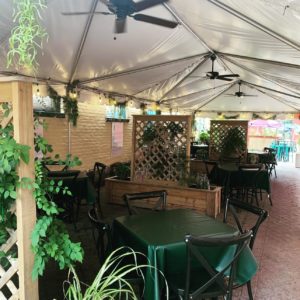
[Photo courtesy Beth Anderson, Hattie’s]
Strauss, meanwhile, has secured a Big Top tent.
“We’re tenting the courtyard and will create a warm, fully heated haven filled with grass and beautiful art for the winter,” he says. “There will be plenty of air ventilation and enough room for tables and music. We’re ready. Bring on winter!”
Some people thrive in a crisis. Cities like Saratoga Springs are lucky to have some such people as residents—and will be reaping the benefits, large and small, of having them here during this time. Amid the chaos and uncertainty, cheers to the foresight, determination, and spirit of the people leading the way back.

